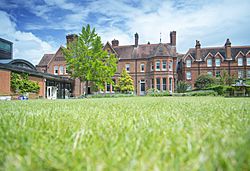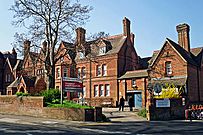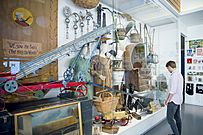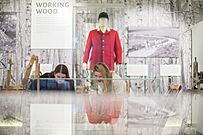Museum of English Rural Life facts for kids

The Museum of English Rural Life
|
|
| Lua error in Module:Location_map at line 420: attempt to index field 'wikibase' (a nil value). | |
| Established | 1951 |
|---|---|
| Location | Reading, Berkshire, England |
| Type | Agricultural museum |
| Accreditation | Arts Council England National Archives |
The Museum of English Rural Life, often called The MERL, is a special place. It's a museum, a library, and an archive all in one. Its main job is to show how farming and country life in England have changed over time. The University of Reading runs The MERL. You can find it in Reading, a town in southern England. It's on Redlands Road, behind the university's London Road Campus. This building used to be called East Thorpe House and later St Andrew's Hall. It's officially recognized as a top museum and archive by important groups like Arts Council England and National Archives.
Contents
The MERL's Story: How It Began
The museum building has an interesting past. It started as a house called East Thorpe. A famous architect, Alfred Waterhouse, designed it in 1880. It was built for Alfred Palmer, who was part of the well-known Huntley & Palmers biscuit company in Reading.
From House to University Hall
Alfred Palmer was a big supporter of the University of Reading. In 1911, East Thorpe house became bigger. It was renamed St Andrew's Hall. This hall was a place where women students at the university could live.
The Museum Opens Its Doors
The Museum of English Rural Life itself started in 1951. It grew from the university's long history of studying farming. Many of the first items in the museum came from the collections of H. J. Massingham and Lavinia Smith. The museum first opened to the public in 1955. It was located on the university's main Whiteknights Campus at that time.
A New Home for The MERL
St Andrew's Hall stopped being a student residence in 2001. After that, the site was made ready for the museum. This big project cost about £11 million. The university, the Heritage Lottery Fund, and public donations helped pay for it. The newly improved museum opened in 2005. It still has the original East Thorpe building. A new building was added next to it. These two different buildings look out over beautiful, restored gardens. It's a unique spot for a country-themed collection right in the middle of a city.
Exciting New Galleries
The museum had more improvements between 2013 and 2016. The Heritage Lottery Fund, the Wellcome Trust, and the University of Reading helped pay for these changes. The museum officially reopened on October 22, 2016. It now had ten brand new galleries. One special gallery shows artwork from Ladybird Books, which the University of Reading keeps in its special collections.
MERLin the Bat and 51 Voices
In February 2019, a bat was found living at the museum! The museum staff named him MERLin and even gave him his own library card. To celebrate its 70th birthday, the museum started a project called "51 Voices." Artists and writers worked together to share their thoughts on objects from 1951 in the museum's collections.
What You Can See: The MERL's Collections
The Museum of English Rural Life has very important collections. These collections are recognized as being nationally significant. They include all sorts of things: objects, old papers, photographs, films, and books. It's also where the University of Reading keeps its special collections archive. This archive holds hundreds of rare books, handwritten documents, typed papers, and other important items.
Treasures of Rural England
The museum has over 25,000 objects. Almost all of them are on display for you to see. These items show what rural England was like from 1750 up to today. You can find paintings of farm animals and pictures of country life. There are also old farm tools, ploughs, and big farm machines. You can even see old sewing machines and other equipment.
A Library for History Buffs
The museum also has a special library. It's full of books about farming and country life. It also holds other collections, like the library of the Tools & Trades History Society.
Gallery






